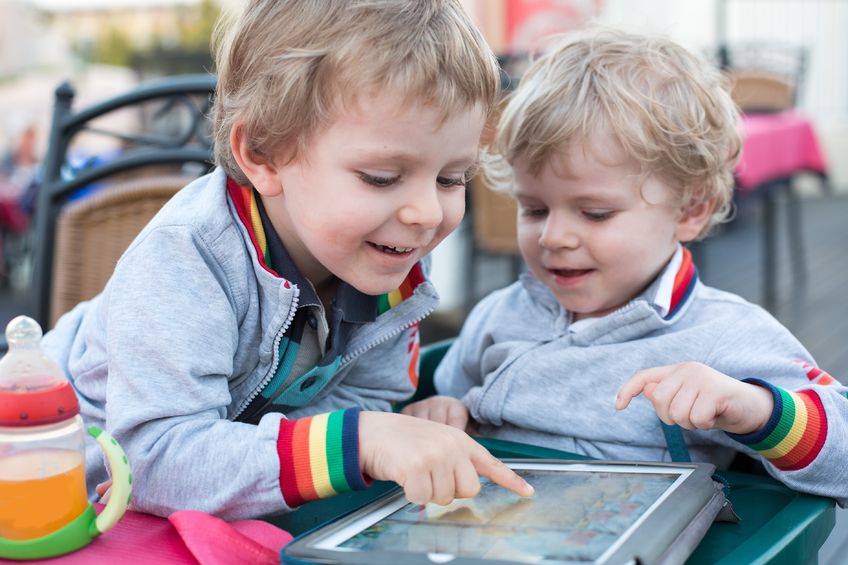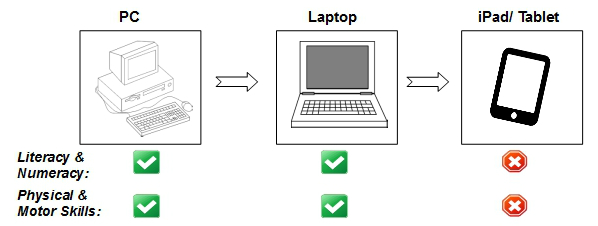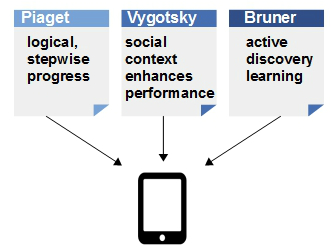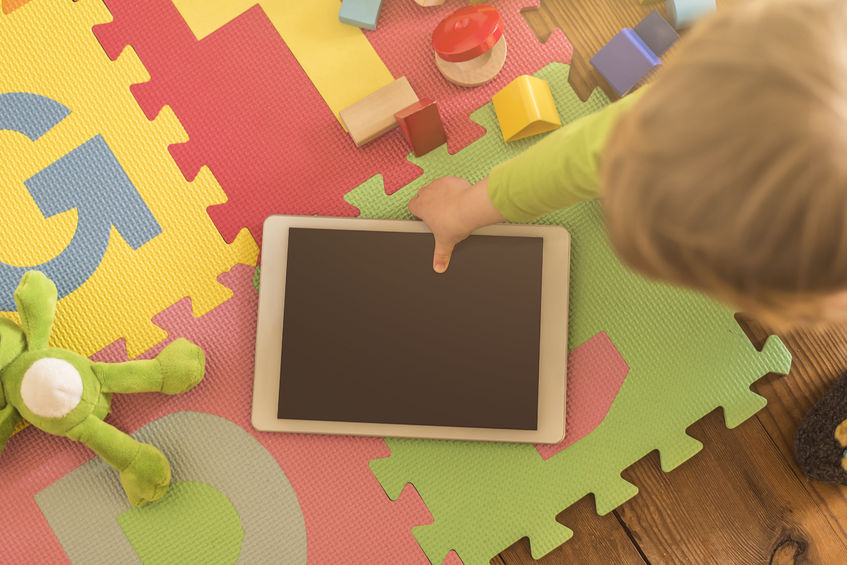
Childcare Environments
Tots and Touchscreens: 21st-Century Digital Natives
‘And then I know that all I’ve learned, my kid assumes.
And all my deepest worries must be his cartoons.’
Younger Generation by John Sebastian (The Lovin’ Spoonful) – 1968
In this song about his yet unborn child – revealed to the world at the 1969 Woodstock Festival – John Sebastian captures the bittersweet concerns of every parent. Back then, the ‘hottest’ technologies still owed much to pioneers like Bell, Marconi and Baird (phone/ radio/ TV) and although the song makes a predictive reference to a three-year-old who has ‘got her own videophone’ (Sebastian, 1968), the tech landscape created by the likes of Jobs (Apple), Page & Brin (Google) and Zuckerberg (Facebook) was still many decades away. Now those days are with us, questions such as: ‘How will this technology shape our children?’ and ‘How will our children use this technology to mould their world?’ are the subject of much speculative debate.
The cultural ratchet
Arguably, almost every innovative technology seems to possess both beneficial and threatening implications, and the accelerating pace of change poses an acute dilemma for parents and educators who, as Fisch points out, are raising and nurturing children:
‘… for jobs that don’t yet exist, using technologies that haven’t yet been invented, in order to solve problems we don’t even know are problems yet.’ (Fisch, 2008)
Psychologists conceptualise this generational tension as a ‘cultural ratchet’: the new generation of children automatically embrace and easily master the technologies of the preceding generation. Meanwhile, adults find the forthcoming innovations introduced by that new generation much harder to adopt.

As Gopnik explains, there is a simple neurological explanation for such ‘adult learning difficulties’:
‘There is a substantial difference between the kind of learning we do as adults, or even as older children, and the kind of learning we do before we are five. For adults, learning mostly requires effort and attention; for babies, learning is ubiquitous and automatic. Grown-up brains are more “plastic” than we once thought, (neural connections can rewire) but very young brains are far more plastic—young children’s brains are designed to learn.’ (Gopnik, 2015)
Going on to address the consequent disconnect between perceptions of the past and present, Gopnik also observes:
‘The latest click of the ratchet is so vivid that the regularities of history are hard to see. Inevitably, the year before you were born looks like Eden, and the year after your children were born looks like “Mad Max” …’
Today’s digital natives
Though we tend to think of our smartphone-oriented, tech-savvy ‘millennial’ generation as digital natives, this is not entirely accurate. This group only began to adopt truly cyber lifestyles during their teenage years – just as the plasticity of their brains was set to decline. By contrast, today’s early years children have been born into a world where:
‘In the UK, eight in ten children aged three to four live in a house with access to the Internet … Two-thirds of children aged three to four live in a household with a tablet computer in the home.’ (Kaye, 2016)
“These children will be the first generation to experience an immersive digital childhood where they learn to operate and communicate with computers just like earlier generations learned language”
Thus the term digital natives only rightly applies to children who can ‘assume’ this environment and are destined to grow up in it. Puerling’s anecdotal evidence (about a three-year-old receiving a toy phone as a birthday present) illustrates how this truth plays out in everyday life:
‘… [when] I showed her that we could only have pretend conversations … she then looked at me sympathetically, explaining, “They should have given you a sim card when you got this – they don’t work without sim cards, Nanny” …’ (Puerling, n.d.)
Touchscreen revolution
Until recently, accepted wisdom had determined that no one could effectively use a computer for meaningful learning without the prerequisite skills of literacy and numeracy. Furthermore, as Figure 1.1 shows, screen access and data input via keyboard typing and mouse manipulation also demanded the control and development of physical– and fine-motor skills. These restrictions naturally exclude almost all children under five, and thus virtually no computer user’s brain could ever be in that ultra-plastic ‘born to learn’ mode of the very young.

Figure 1.1 The implications of touchscreen access
The advent of touchscreens and voice activation has fundamentally changed how we use computers, and even more crucially, who is capable of gaining access. Touchscreen tablets and smartphones now allow even young babies to interact with software apps of every description. These children will be the first generation to experience an immersive digital childhood where they learn to operate and communicate with computers just like earlier generations learned language: assimilation through constant intercommunication, which promotes deep learning via a process of osmosis. And importantly, this learning journey will be well under way even earlier than their parents first began to learn to read and count.
Early interactions
From a child’s perspective, getting to grips with a tablet is just as simple as exploring any other toy:
‘Touch technology follows the same logic as shaking a rattle or knocking down a pile of blocks: the child swipes and something immediately happens.’ (Rosin, 2013)
More than confirming this assertion, Geist’s research study with two-year-olds introduced children to iPads in much the same manner as they might be provided with play-dough or similar creative materials, and then prompted to explore. With the briefest of instructions and minimal adult support, they learned the ‘tap’ required in one session. After a second interactive session, the children were becoming experts – making adjustments and navigating to the apps they wished to use. Commenting on the outcomes, the author noted:
‘The degree of interactivity and independence with the devices was truly amazing, but only because the iPad was able to support the natural curiosity of the toddlers in the study.’ (Geist, 2012)
Sociocultural perspectives
In the meantime, and regardless of whether educators in early years settings choose to exploit such materials, children are growing up in a contemporary world where smart digital technologies are pervasive, and thus where rich possibilities exist for informal learning. At this point, it may be useful to review the constructivist learning theories of Piaget, Vygotsky and Bruner, briefly summarised in Figure 1.2, to help to explain what is now going on in so many homes.

Figure 1.2 The contribution of constructivist learning theories
Piaget’s theory of child development (Piaget, 1936) shows that children’s learning is driven by processes of adaptive accommodation and assimilation. These functions help to build a series of interdependent logical structures enabling a child’s understanding to progress in a series of steps. Essentially, this allows learners to move forward at their own pace and access material tailored to their current level of maturity and understanding – something today’s well-designed and highly motivating computer apps are tailor-made to support. Furthermore, Piaget also demonstrated that young children have ways of thinking which differ from the adult modes they will acquire later – an early echo of the views Gopnik and others have more-recently formulated about the awesome learning instincts of the very young.
And similarly, Vygotsky’s recognition of the importance of the social aspects of learning accounts for the ease with which even the youngest children respond to computer learning tools. Their world is full of familiar digital devices and they are surrounded by others they love and respect whom they constantly witness accessing these features. What is more, parents and siblings are available at home to support and promote informal learning via these new tools – a process Vygotsky would call ‘scaffolding’. As a result of such guidance and nurturing, these children are frequently capable of functioning well beyond their notional level of development. Vygotsky (1978) described this same phenomena of enhanced performance in the presence of optimised support as a ‘zone of proximal development’ – a factor which today’s educators believe to be a powerful mechanism for advancement.

Building on Piaget’s earlier work, Bruner’s cognitive development theory saw the learner as an active participant in educational exchanges and believed that children learn best when allowed to discover and construct knowledge for themselves. According to Bruner (1973), another essential aspect of a young child’s learning involves the regular revisiting and reinforcement of earlier core concepts – each time in increasingly sophisticated detail. Once again, these features are well represented in modern software aimed at the youngest children.
A natural predisposition
For these young children, an iPad or tablet seems to be a natural, intuitive learning tool. Just simply exploring allows them instant physical control (via tapping, swiping etc.), and screen icons facilitate rapid communication, whilst the ability to engage with such devices just as their parents do is a deeply satisfying achievement. And whilst the impact of this groundbreaking development will not become fully apparent for perhaps a decade or two, it is abundantly clear such tools do far more than reinforce traditional learning.
Read more about the potential implications of technology in the early years in Kathy Brodie’s article: The Debate About Digital Technologies In The Nursery
Touchscreen technology offers a totally new way of engaging children which seems destined to create a genuine cultural shift. The challenge for childcare professionals will be to decide the best ways to integrate this new perspective and monitor its implications for child development. The signs are that those who delay their response will soon find themselves sidelined and well out of the loop.







1 Comment
You must be logged in to post a comment Login